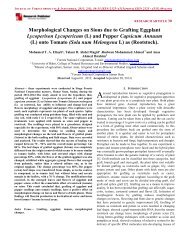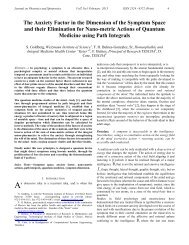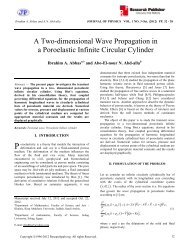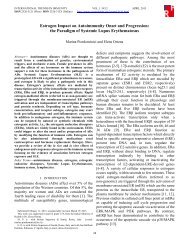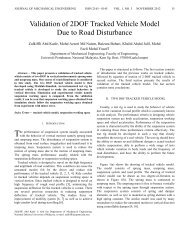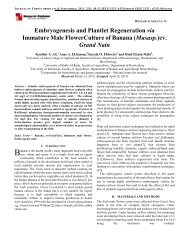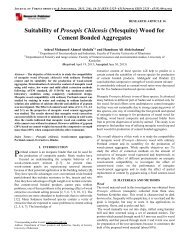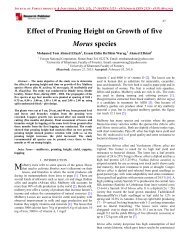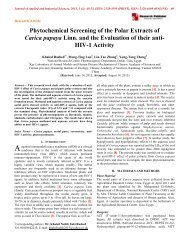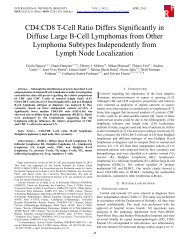Effect of Wrapping Materials on the Proximate Composition and ...
Effect of Wrapping Materials on the Proximate Composition and ...
Effect of Wrapping Materials on the Proximate Composition and ...
- No tags were found...
You also want an ePaper? Increase the reach of your titles
YUMPU automatically turns print PDFs into web optimized ePapers that Google loves.
INTERNATIONAL JOURNAL OF FOOD AND NUTRITION SCIENCE VOL2 NO1 AUGUST 2013ISSN 2165-5308 (PRINT) ISSN 2165-5316 (ONLINE) http://www.researchpub.org/journal/ijfns/ijfns.html<strong>the</strong>se samples could be due to variati<strong>on</strong> <str<strong>on</strong>g>of</str<strong>on</strong>g> wrappingmaterials. Since <strong>the</strong> same sample was used, <strong>the</strong> FILmay have retained more moisture than <strong>the</strong> o<strong>the</strong>rsamples during <strong>the</strong> cooking period, or <strong>the</strong> o<strong>the</strong>rmaterials may have lost moisture during cooking.The percentage mean values <str<strong>on</strong>g>of</str<strong>on</strong>g> <strong>the</strong> protein c<strong>on</strong>tents<str<strong>on</strong>g>of</str<strong>on</strong>g> <strong>the</strong> Usu samples were 15.8, 15.37. 15.69. 15.79<strong>and</strong> 14.07 for wrapping samples CBL, MFL, ABL,MF <strong>and</strong> FIL respectively.TABLE IIEFFECT OF WRAPPING MATERIALS ON PROXIMATE COMPOSITION OF “USU” AN INDIGENOUSMEAT ANALOGUE.Samples Moisture Protein Fat Crude Fibre Ash CHOCBL 13.38 a 15.8 a 25.15 a 3.78 a 5.65 a 36.28 aMFL 13.27 a 15.37 a 29.28 a 4.92 a 5.22 a 31.96 aABL 17.70 a 15.69 a 28.81 a 5.00 a 4.06 a 28.76 aMF 10.49 a 15.79 a 28.99 a 5.63 a 5.79 a 33.32 aFIL 17.93 a 14.07 a 28.70 a 4.88 a 5.65 a 31.30 aLSD 9.47 2.09 10.32 4.27 2.79 8.00Means in <strong>the</strong> same column with <strong>the</strong> same superscript are significantly similar (P < 0.05)NOTE:CBL = Christmas bush leaves (Alchornea cordifolia)MFL =Miraculous fruit leaves (Thaumatococcus daniellii),ABL = African border Leaves (Newbouldia laevis seem)AS = Asusu Leaves (Manniophyt<strong>on</strong> fulvum)FIL = Aluminum FoilThe protein c<strong>on</strong>tents were not statistically different at5% c<strong>on</strong>fidence interval, though <strong>the</strong> sample wrappedwith aluminum foil (FIL) had <strong>the</strong> lowest percentage<str<strong>on</strong>g>of</str<strong>on</strong>g> protein c<strong>on</strong>tent. Generally, <strong>the</strong> protein c<strong>on</strong>tent <str<strong>on</strong>g>of</str<strong>on</strong>g>all <strong>the</strong> samples were relatively high because, <strong>the</strong> bigmushroom <strong>and</strong> mel<strong>on</strong> used in <strong>the</strong> producti<strong>on</strong> <str<strong>on</strong>g>of</str<strong>on</strong>g> Ususamples are good sources <str<strong>on</strong>g>of</str<strong>on</strong>g> protein [14; 15; 16; 17].The fat c<strong>on</strong>tent <str<strong>on</strong>g>of</str<strong>on</strong>g> <strong>the</strong> Usu wrapped in differentwrapping materials were not significantly different (P< 0.05), although <strong>the</strong>re were differences in <strong>the</strong>irpercentage mean values ranging from 25.70% to29.28%. MFL samples had relatively high fat c<strong>on</strong>tentwhile FIL showed <strong>the</strong> lowest percentage <str<strong>on</strong>g>of</str<strong>on</strong>g> fatc<strong>on</strong>tent <strong>and</strong> this may be due to wrapping materialvariati<strong>on</strong>s as <strong>the</strong> raw leaves material used may havec<strong>on</strong>tributed to high fat c<strong>on</strong>tent <str<strong>on</strong>g>of</str<strong>on</strong>g> samples [15; 16].The ash c<strong>on</strong>tent <str<strong>on</strong>g>of</str<strong>on</strong>g> <strong>the</strong> Usu sample ranged from4.06% to 5.79% <strong>and</strong> <strong>the</strong>y were significantly similardespite slight variati<strong>on</strong> in <strong>the</strong>ir percentage meanvalue. The crude fibre c<strong>on</strong>tent followed <strong>the</strong> samepattern with percentage mean value ranging from3.78 to 5.63. There is no significant difference at 5%c<strong>on</strong>fidence interval. The carbohydrate percentagemean values ranged from 28.76 to 36.28, havingvariati<strong>on</strong>s in <strong>the</strong> value but significantly indifferent.The proximate compositi<strong>on</strong>s <str<strong>on</strong>g>of</str<strong>on</strong>g> <strong>the</strong>se samples wereso because <strong>the</strong>y were from <strong>the</strong> same mixture, <strong>the</strong>differences were from <strong>the</strong> wrapping materials.Therefore, any difference in proximate values couldbe from <strong>the</strong> wrapping materials effect.B. <str<strong>on</strong>g>Effect</str<strong>on</strong>g> <str<strong>on</strong>g>of</str<strong>on</strong>g> <str<strong>on</strong>g>Wrapping</str<strong>on</strong>g> <str<strong>on</strong>g>Materials</str<strong>on</strong>g> <strong>on</strong> <strong>Proximate</strong>Compositi<strong>on</strong> at Varying RatiosTable 3 shows <strong>the</strong> percentage mean composite values<str<strong>on</strong>g>of</str<strong>on</strong>g> Usu samples for 70:30 <strong>and</strong> 80:20 egusi: erousuratios, wrapped in different wrapping materials.From <strong>the</strong> results <str<strong>on</strong>g>of</str<strong>on</strong>g> <strong>the</strong> statistical analysis, <strong>the</strong> varyingratios <str<strong>on</strong>g>of</str<strong>on</strong>g> <strong>the</strong> Usu sample wrapped with differentwrapping materials showed no significant differencein <strong>the</strong>ir percentage moisture mean value. Sample A(70:30) had 14.87% while sample B (80:20) had14.23% respectively. The percentage protein meanvalues were 15.08% <strong>and</strong> 15.6% for samples A (70:30)<strong>and</strong> B (80:20) respectively.42



